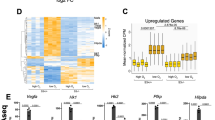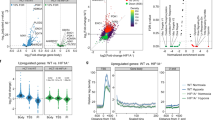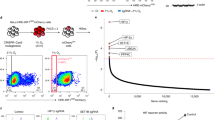Abstract
The ternary complex factor Net/Elk3 is downregulated in hypoxia and participates in the induction by hypoxia of several genes, including c-fos, vascular endothelial growth factor and egr-1. However, the global role of Net in hypoxia remains to be elucidated. We have identified, in a large-scale analysis of RNA expression using microarrays, more than 370 genes that are regulated by Net in hypoxia. In order to gain insights into the role of Net in hypoxia, we have analysed in parallel the genes regulated by HIF-1α, the classical factor involved in the response to hypoxia. We identified about 190 genes that are regulated by HIF-1α in hypoxia. Surprisingly, when we compare the genes induced by hypoxia that require either Net or HIF-1α, the majority are the same (75%), suggesting that the functions of both factors are closely linked. Interestingly, in hypoxia, Net regulates the expression of several genes known to control HIF-1α stability, including PHD2, PHD3 and Siah2, suggesting that Net regulates the stability of HIF-1α. We found that inhibition of Net by RNAi leads to decreased HIF-1α expression at the protein level in hypoxia. These results indicate that Net participates in the transcriptional response to hypoxia by regulation of HIF-1α protein stability.
This is a preview of subscription content, access via your institution
Access options
Subscribe to this journal
Receive 50 print issues and online access
$259.00 per year
only $5.18 per issue
Buy this article
- Purchase on Springer Link
- Instant access to full article PDF
Prices may be subject to local taxes which are calculated during checkout




Similar content being viewed by others
References
Aprelikova O, Wood M, Tackett S, Chandramouli GV, Barrett JC . (2006). Role of ETS transcription factors in the hypoxia-inducible factor-2 target gene selection. Cancer Res 66: 5641–5647.
Ayadi A, Zheng H, Sobieszczuk P, Buchwalter G, Moerman P, Alitalo K et al. (2001). Net-targeted mutant mice develop a vascular phenotype and up-regulate egr-1. EMBO J 20: 5139–5152.
Brahimi-Horn C, Berra E, Pouyssegur J . (2001). Hypoxia: the tumor's gateway to progression along the angiogenic pathway. Trends Cell Biol 11: S32–6.
Buchwalter G, Gross C, Wasylyk B . (2004). Ets ternary complex transcription factors. Gene 324: 1–14 [Review].
Buchwalter G, Gross C, Wasylyk B . (2005). The ternary complex factor net regulates cell migration through inhibition of PAI-1 expression. Mol Cell Biol 25: 10853–10862.
Criqui-Filipe P, Ducret C, Maira SM, Wasylyk E . (1999). Net, a negative Ras-switchable TCF, contains a second inhibition domain, the CID, that mediates repression through interactions with CtBP and de-acetylation. EMBOJ 18: 3392–3403.
Giovane A, Pintzas A, Maira SM, Sobieszczuk P, Wasylyk B . (1994). Net, a new ets transcription factor that is activated by Ras. Genes DeV 8: 1502–1513.
Greijer AE, van der Groep P, Kemming D, Shvarts A, Semenza GL, Meijer GA et al. (2005). Up-regulation of gene expression by hypoxia is mediated predominantly by hypoxia-inducible factor 1 (HIF-1). J Pathol 206: 291–304.
Gross C, Buchwalter G, Dubois-Pot H, Cler E, Zheng H, Wasylyk B . (2007). The ternary complex factor Net is downregulated by hypoxia and regulates hypoxia-responsive genes. Mol Cell Biol 27: 4133–4141.
Harris AL . (2002). Hypoxia—a key regulatory factor in tumour growth. Nat Rev Cancer 2: 38–47.
Iyer NV, Kotch LE, Agani F, Leung SW, Laughner E, Wenger RH et al. (1998). Cellular and developmental control of O2 homeostasis by hypoxia-inducible factor 1 alpha. Genes Dev 12: 149–162.
Le Brigand K, Russell R, Moreilhon C, Rouillard JM, Jost B, Amiot F et al. (2006). An open-access long oligonucleotide microarray resource for analysis of the human and mouse transcriptomes. Nucleic Acids Res 34: E87.
Maira SM, Wurtz JM, Wasylyk B . (1996). Net (ERP/SAP2) one of the Ras-inducible TCFs, has a novel inhibitory domain with resemblance to the helix-loop-helix motif. EMBO J 15: 5849–5865.
Manalo DJ, Rowan A, Lavoie T, Natarajan L, Kelly BD, Ye SQ et al. (2005). Transcriptional regulation of vascular endothelial cell responses to hypoxia by HIF-1. Blood 105: 659–669.
Nakayama K, Frew IJ, Hagensen M, Skals M, Habelhah H, Bhoumik A et al. (2004). Siah2 regulates stability of prolyl-hydroxylases, controls HIF1alpha abundance, and modulates physiological responses to hypoxia. Cell 117: 941–952.
Pugh CW, Ratcliffe PJ . (2003). Regulation of angiogenesis by hypoxia: role of the HIF system. Nat Med 9: 677–684.
Ryan HE, Lo J, Johnson RS . (1998). HIF-1 alpha is required for solid tumor formation and embryonic vascularization. EMBO J 17: 3005–3015.
Semenza GL . (2001). HIF-1, O(2), and the 3 PHDs: how animal cells signal hypoxia to the nucleus. Cell 107: 1–3.
Semenza GL . (2003). Targeting HIF-1 for cancer therapy. Nat Rev Cancer 3: 721–732.
Stiehl DP, Wirthner R, Koditz J, Spielmann P, Camenisch G, Wenger RH . (2006). Increased prolyl 4-hydroxylase domain proteins compensate for decreased oxygen levels. Evidence for an autoregulatory oxygen-sensing system. J Biol Chem 281: 23482–23491.
van Riggelen J, Buchwalter G, Soto U, De-Castro Arce J, Hausen HZ, Wasylyk B et al. (2005). Loss of net as repressor leads to constitutive increased c-fos transcription in cervical cancer cells. J Biol Chem 280: 3286–3294.
Zheng H, Wasylyk C, Ayadi A, Abecassis J, Schalken JA, Rogatsch H et al. (2003). The transcription factor Net regulates the angiogenic switch. Genes Dev 17: 2283–2297.
Acknowledgements
We thank the DNA microarray platform, and above all Christine Bole-Feysot, Bernard Jost, Doulaye Dembele, Philippe Kastner, for their expert, professional and friendly help, the Wasylyk laboratory members for support and encouragement and the IGBMC core facilities. CG received fellowships from the Ministere de la Recherche et Technologie, the Association pour la Recherche contre le Cancer and the Regional Council of Alsace. HD and CG received a fellowship from the Ministere de la Recherche et Technologie. The Wasylyk laboratory is financially supported by the Association pour la Recherche contre le Cancer, the Ligue Nationale Française contre le Cancer (Equipe labellisee), (the Ligue Regionale (Bas-Rhin) contre le Cancer and the Ligue Regionale (Haut-Rhin) contre le Cancer), the Centre National de la Recherche Scientifique, the Institut National de la Sante et de la Recherche Medicale, the EU (FP5 Procure project QLK6-2000–00159 and FP6 Prima project #504587), AICR (05–390) and, as part of the Cancéropôle Grand-Est, by INCa and the Ministry of Research and Higher Education (the Axe IV and DKFZ-CGE projects).
Author information
Authors and Affiliations
Corresponding author
Additional information
Supplementary Information accompanies the paper on the Oncogene website (http://www.nature.com/onc)
Rights and permissions
About this article
Cite this article
Gross, C., Dubois-Pot, H. & Wasylyk, B. The ternary complex factor Net/Elk-3 participates in the transcriptional response to hypoxia and regulates HIF-1α. Oncogene 27, 1333–1341 (2008). https://doi.org/10.1038/sj.onc.1210736
Received:
Revised:
Accepted:
Published:
Issue Date:
DOI: https://doi.org/10.1038/sj.onc.1210736
Keywords
This article is cited by
-
The Elk-3 target Abhd10 ameliorates hepatotoxic injury and fibrosis in alcoholic liver disease
Communications Biology (2023)
-
Brain transcriptome analysis reveals subtle effects on mitochondrial function and iron homeostasis of mutations in the SORL1 gene implicated in early onset familial Alzheimer’s disease
Molecular Brain (2020)
-
Immune-related genes in tumor-specific CD4+ and CD8+ T cells in colon cancer
BMC Cancer (2020)
-
HIF-1α-Dependent Gene Expression Program During the Nucleic Acid-Triggered Antiviral Innate Immune Responses
Molecules and Cells (2009)



